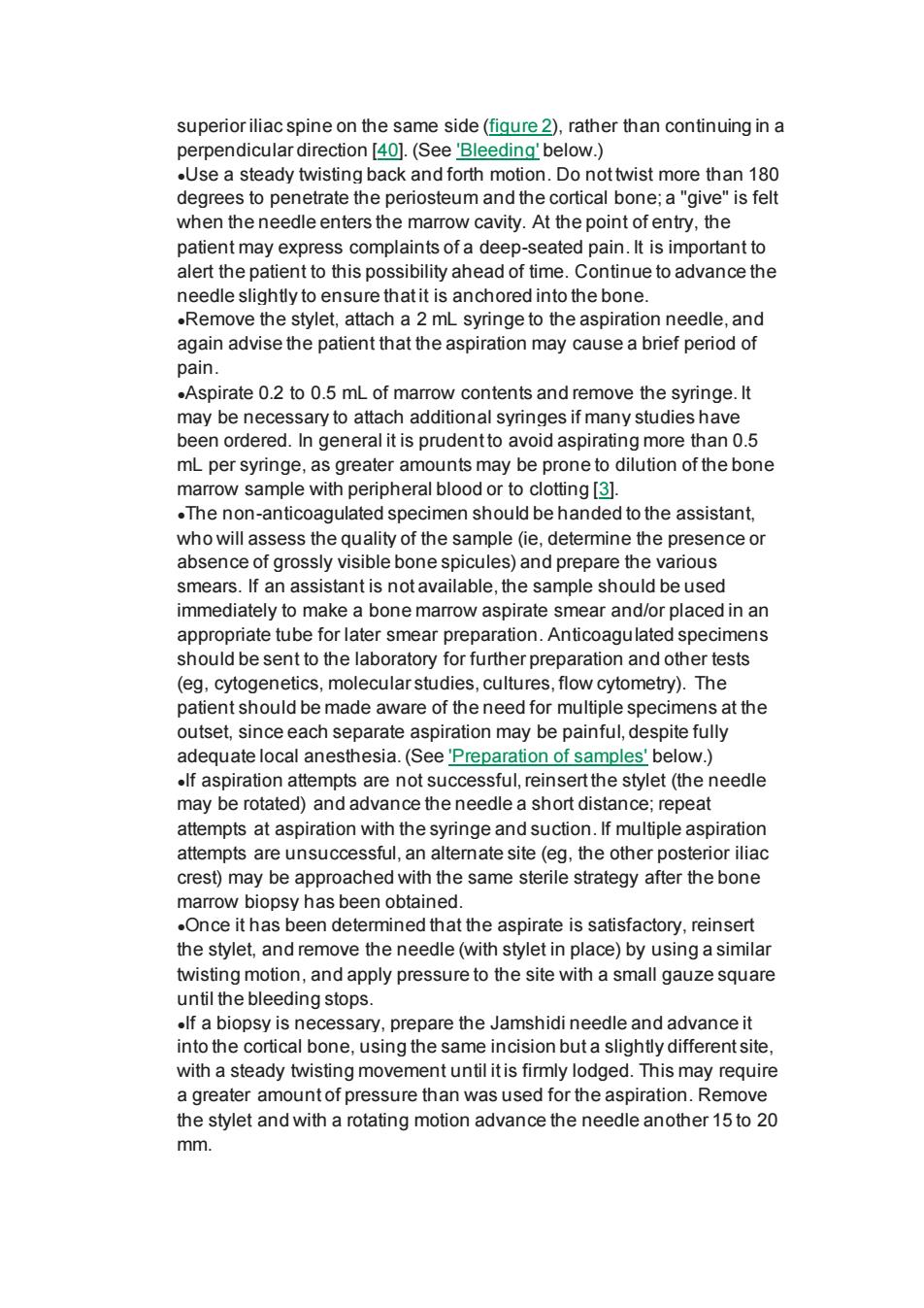正在加载图片...

superior iliac spine on the same side(figure 2),rather than continuing in a Do not twist more than 180 degrees to penetrate the periosteum and the cortical bone;a"give"is felt when the needle enters the marrow cavity.At the point of entry.the patient may express complaints of a deep-seated pain.it is important to alert the patient to this possibility ahead of time.Continue to advance the needle sli tly to ensure thatit i anchored into the b .Remove the stylet,attach a 2 mL syringe to the aspiration needle,and again advise the patient that the aspiration may cause a brief period of pain Aspirate o 2 to o 5 mL of marrow contents and remove the syringe it may be n ary to a if many studie an0.5 mL per syringe,as greater amounts may be prone to dilution of the bone marrow sample with peripheral blood or to clotting [3]. .The non-anticoaqulated specimen should be handed to the assistant. who will assess the quality of the sar presence o of grossly visible s)and prepare the smears.If an assistant is not available,the sample should be used immediately to make a bone marrow aspirate smear and/or placed in an appropriate tube for later smear preparation.Anticoagulated specimens should be sent to the laboratory for further preparation and other tests (g,cytogenetics dies ,cultur s,flow cytome 以 The patient should be made aware of the need for multiple spec ens at the outset,since each separate aspiration may be painful,despite fully adequate local anesthesia.(See 'Preparation of samples'below. -If aspiration attempts are not successful reinsert the stylet (the needle ay be rotated)a d advance the needle a short distance:repeat attempts at aspiration with the syringe and suction.If multiple aspiratior attempts are unsuccessful,an alternate site (eg.the other posterior iliad crest)may be approached with the same sterile strategy after the bone marrow biopsy has been obtained. .Once it has been determined that the aspirate is satisfactory reinsert the stylet,and remove the needle(with stylet in place)by using a similar twisting motion,and apply pressure to the site with a small gauze square until the bleeding stops. .If a biopsy is necessary.prepare the Jamshidi needle and advance it into the cortical bone.using the same incision but a slightly different site with a steady twisting mov ment until itis firmly lodged.This may requ re a greater amount of pressure than was used for the aspiration.R the stylet and with a rotating motion advance the needle another 15 to 20 mm. superior iliac spine on the same side (figure 2), rather than continuing in a perpendicular direction [40]. (See 'Bleeding' below.) ●Use a steady twisting back and forth motion. Do not twist more than 180 degrees to penetrate the periosteum and the cortical bone; a "give" is felt when the needle enters the marrow cavity. At the point of entry, the patient may express complaints of a deep-seated pain. It is important to alert the patient to this possibility ahead of time. Continue to advance the needle slightly to ensure that it is anchored into the bone. ●Remove the stylet, attach a 2 mL syringe to the aspiration needle, and again advise the patient that the aspiration may cause a brief period of pain. ●Aspirate 0.2 to 0.5 mL of marrow contents and remove the syringe. It may be necessary to attach additional syringes if many studies have been ordered. In general it is prudent to avoid aspirating more than 0.5 mL per syringe, as greater amounts may be prone to dilution of the bone marrow sample with peripheral blood or to clotting [3]. ●The non-anticoagulated specimen should be handed to the assistant, who will assess the quality of the sample (ie, determine the presence or absence of grossly visible bone spicules) and prepare the various smears. If an assistant is not available, the sample should be used immediately to make a bone marrow aspirate smear and/or placed in an appropriate tube for later smear preparation. Anticoagulated specimens should be sent to the laboratory for further preparation and other tests (eg, cytogenetics, molecular studies, cultures, flow cytometry). The patient should be made aware of the need for multiple specimens at the outset, since each separate aspiration may be painful, despite fully adequate local anesthesia. (See 'Preparation of samples' below.) ●If aspiration attempts are not successful, reinsert the stylet (the needle may be rotated) and advance the needle a short distance; repeat attempts at aspiration with the syringe and suction. If multiple aspiration attempts are unsuccessful, an alternate site (eg, the other posterior iliac crest) may be approached with the same sterile strategy after the bone marrow biopsy has been obtained. ●Once it has been determined that the aspirate is satisfactory, reinsert the stylet, and remove the needle (with stylet in place) by using a similar twisting motion, and apply pressure to the site with a small gauze square until the bleeding stops. ●If a biopsy is necessary, prepare the Jamshidi needle and advance it into the cortical bone, using the same incision but a slightly different site, with a steady twisting movement until it is firmly lodged. This may require a greater amount of pressure than was used for the aspiration. Remove the stylet and with a rotating motion advance the needle another 15 to 20 mm